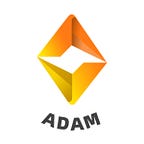The essence of blockchain technology is to turn data into objective facts and code into a system. Open and transparent on-chain data and self-executing smart contracts are valuable assets brought by the development of the industry. The blockchain exposes all on-chain behaviors to the society, and whether it can be properly utilized will be a major topic for the development of the industry.
In fact, there are many ways to process the data on the chain, such as off-chain exchange and on-chain smart contracts exchange. Essentially, any data between public chains can be valued based on cross-chain applications. ADAM, the first encrypted data network based on Web3.0, is a typical representative of such applications.
Users who have used on-chain blockchain browsers should understand that each on-chain behavior can be expressed and seen digitally; each on-chain data can be interpreted or marked. Therefore, some excellent on-chain data applications have evolved in the market, such as Tokenview’s data monitoring, which can be used to guide transactions or predict the market.
For another example, ADAM’s data tracking plug-in artificially classifies tags (defines attributes) based on some on-chain behaviors. As a simple example, ADAM can make each wallet have a personality, such as what belongs to “giant whale”, what belongs to “holders”, etc., and then to more detailed visualization for each wallet address.
ADAM’s pace of on-chain data visualization can not only be used in DeFi or NFT, but also spread financial behaviors into creation and social activities and the Web3.0s ecosystem. On-chain attention touches much more than the simple act of on-chain transactions.
The data representing attention are:
purchase and sell on opensea or other NFT marketplace (collection behavior)
curation among/across marketplaces (display preference data)
This attention data visualization presents the transfer of ownership of NFTs as a social relationship in the form of social flows (eg, graphs). You can understand it as an NFT public Twitter stream, each wallet address is equivalent to a twitter account, and you can follow the NFT collection trends of a specific wallet address (ENS).
The trend of on-chain data value development must be unstoppable. In this regard, more and more institutions will enter the market, which means that in the future, everyone’s behavior or attention on the chain, and everyone’s digital identity will change. become more and more clear. Then this raises two (possibly more) needs:
1) Financial privacy involves the privacy protection of financial property data
2) Onchain behavior as CV social/meeting behavior data is interpreted in multiple and refined ways.
In short, the on-chain data is there, and there will be various components that are more and more concrete. Just as ADAM derives the data retrieval, data monitoring plug-in, Oracle and data analysis platform on the chain to visualize the application of the data on the chain. The functions and tools are the same. In the process of mining the value of data on the chain, not only will our attention be proved in various ways, but also our digital identity will become more and more specific. Ultimately, on-chain data will also be given meaning and interesting attributions for different purposes.
